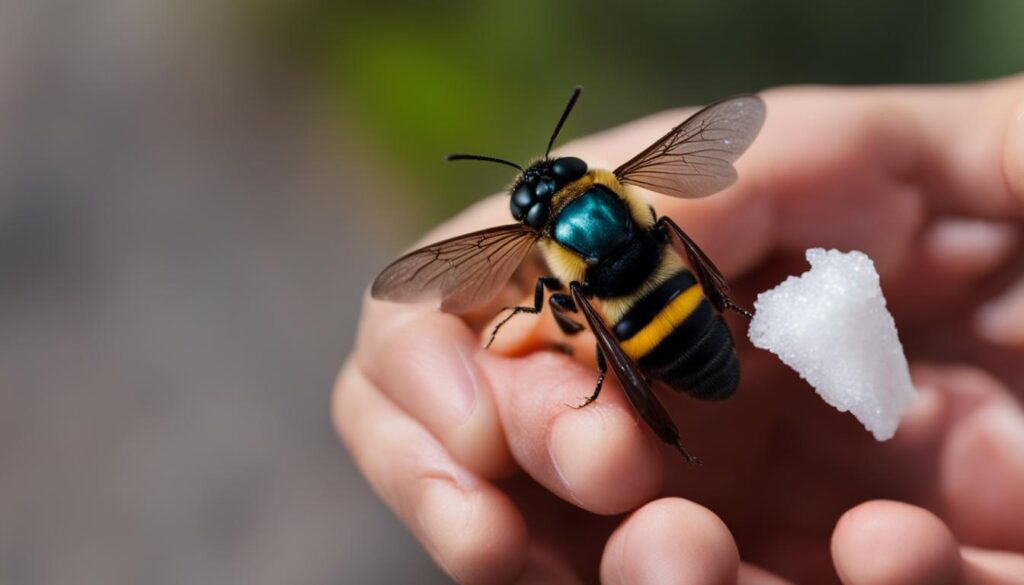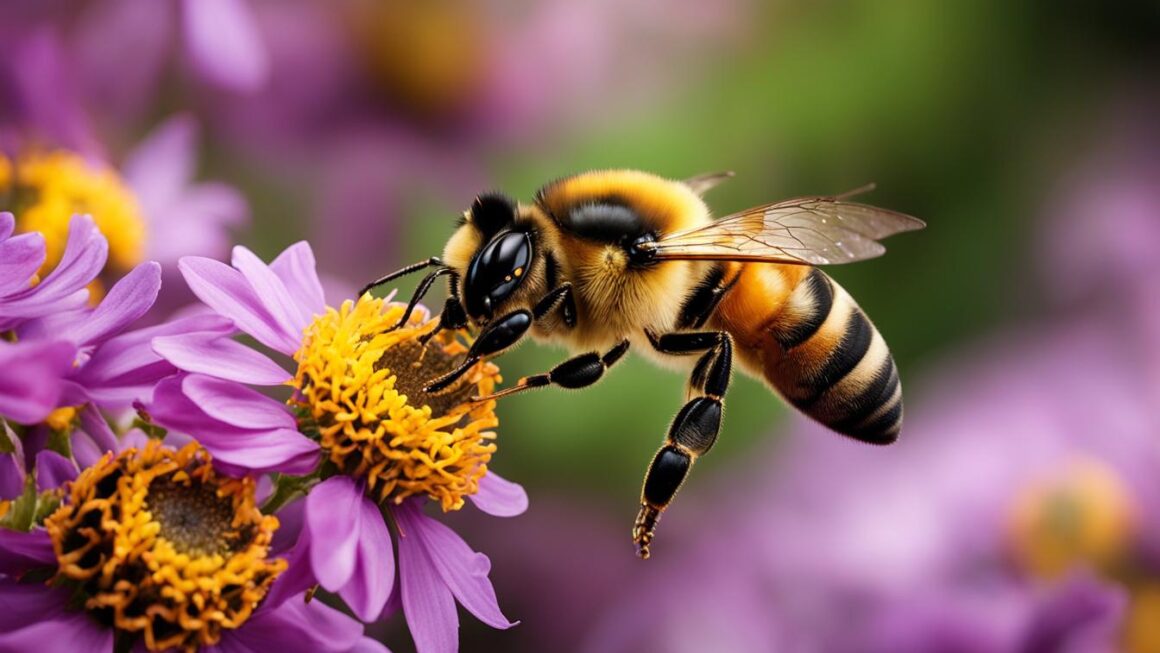When it comes to carpenter bees, their distinctive behaviors and the tunnels they create in wooden structures have long piqued curiosity. One of the frequently asked questions is whether carpenter bees have a stinger. In this section, we will delve into the stinging capabilities of carpenter bees, shedding light on their stingers, stinging behavior, and how to handle encounters.
Female carpenter bees, unlike their male counterparts, do possess stingers. Although these bees are generally non-aggressive, they can deliver a painful sting if threatened or provoked. Male carpenter bees, on the other hand, do not have stingers and primarily act as territorial defenders.
Understanding the stinging behavior of carpenter bees is crucial for fostering harmonious coexistence and minimizing the chances of painful encounters. Read on to explore more about the territorial behavior of male carpenter bees, the stinging ability of female carpenter bees, factors that may provoke a sting, and how to treat carpenter bee stings effectively.
Key Takeaways:
- Carpenter bees have stingers, but only female carpenter bees can deliver a sting.
- Male carpenter bees do not possess stingers and primarily act as territorial defenders.
- Female carpenter bees will sting in self-defense or to protect their nests, but they are generally non-aggressive.
- Disturbing or provoking carpenter bees can provoke a defensive response and increase the chances of a sting.
- Proper treatment, such as removing the stinger, cleaning the area, and applying cold compresses, can help alleviate the discomfort of a carpenter bee sting.
Territorial Behavior of Male Carpenter Bees
Male carpenter bees play a crucial role in defending their territory against potential threats. While they do not possess stingers like their female counterparts, they exhibit distinct territorial behaviors that serve as a deterrent to intruders.
Males can often be seen hovering near their nesting sites, performing intricate flight patterns, and emitting buzzing sounds as a warning to potential adversaries. These behaviors are part of their instinctive defense mechanisms, aimed at safeguarding their territory.
“Male carpenter bees are formidable defenders, even without a stinger. They utilize their size and intimidating flight displays to ward off potential intruders and protect their nests,” explains Dr. Sarah Miller, entomologist at the University of Entomology.
It’s important to note that male carpenter bees are primarily focused on territorial defense and are not aggressive towards humans. Their buzzing and flight displays are often an attempt to establish dominance rather than a direct threat.
| Male Carpenter Bee Territorial Behavior | Notes |
|---|---|
| Hovering near nesting sites | Male carpenter bees often patrol their nesting areas, monitoring for potential threats. |
| Performing flight patterns | They engage in elaborate flight patterns, showcasing their presence and territorial boundaries. |
| Creating buzzing sounds | The buzzing sounds serve as a warning to intruders, signaling their presence and readiness to defend their territory. |
Understanding the territorial behavior of male carpenter bees can help individuals coexist with these fascinating creatures while minimizing any potential concerns or conflicts.
Stinging Ability of Female Carpenter Bees
Female carpenter bees possess stingers that can deliver a painful sting if they feel threatened or provoked. However, it is important to note that these bees are generally non-aggressive and will only sting in self-defense or to protect their nests. It is essential to approach carpenter bees with caution and respect to minimize the chances of encounters and stings.
If stung by a female carpenter bee, prompt action should be taken to alleviate pain and reduce swelling. The first step is to remove the stinger carefully using a pair of tweezers or scraping it off with a credit card. The affected area should then be cleaned with soap and water to reduce the risk of infection.
Applying a cold compress to the sting site can help alleviate pain and reduce swelling. Over-the-counter pain relief medication can also be taken to further alleviate discomfort. If symptoms persist or intensify, it is advisable to seek medical attention for further evaluation and treatment.
Common symptoms of a carpenter bee sting include:
- Redness and swelling at the sting site
- Tenderness and pain
- Itching and irritation
It is important to note that individuals may have varying reactions to carpenter bee stings, and some individuals may be more sensitive or allergic to bee venom. If an allergic reaction occurs, such as difficulty breathing, dizziness, or hives, immediate medical attention should be sought.
| Characteristics | Male Carpenter Bees | Female Carpenter Bees |
|---|---|---|
| Stingers | No stingers | Possess stingers |
| Behavior | Act as territorial defenders | Non-aggressive, sting in self-defense or to protect their nests |
| Appearance | Similar to females but with no stingers | Larger size, possess stingers |
| Role | Defend territory from threats | Build nests, lay eggs, and protect offspring |
Factors That May Provoke a Sting
Disturbing or provoking carpenter bees can lead to a defensive response, potentially resulting in a sting. It is important to approach these insects with caution and respect their space to minimize the chances of encounters and stings.
Some actions that can provoke carpenter bees include swatting at them or directly handling them. These actions are seen as threats, causing the bees to react defensively. Additionally, approaching their nests or making sudden movements near their nesting areas can also trigger a defensive response.
Carpenter bees are sensitive to vibrations, and any disturbances near their nesting sites can lead to defensive behavior. It is advisable to avoid loud noises or excessive movement when in close proximity to carpenter bee nests. By keeping a safe distance and minimizing disruptions, the risk of provoking a sting can be significantly reduced.
Protective Measures to Minimize Provocation
If you find yourself in an area where carpenter bees are present, there are several protective measures you can take to minimize the chances of provoking a sting:
- Avoid wearing bright-colored clothing or floral patterns, as these may attract the attention of carpenter bees.
- Refrain from using strong perfumes or scented products that could potentially agitate the bees.
- When working outdoors, try to stay calm and avoid sudden movements, as these can startle the bees.
- If you notice a carpenter bee behaving aggressively, slowly and calmly move away from the area without swatting or attempting to confront the bee.
By taking these precautions and respecting the space of carpenter bees, you can coexist with these insects without the risk of provoking a sting.

Treating Carpenter Bee Stings
When dealing with a carpenter bee sting, prompt action is essential to alleviate discomfort and reduce the risk of complications. Here are some steps you can take to treat a carpenter bee sting:
- Stay calm: Avoid panicking, as this can elevate your heart rate, potentially causing the venom to spread more quickly.
- Remove the stinger: If the stinger is still embedded in your skin, use a clean pair of tweezers to gently remove it. Be careful not to squeeze or crush the venom sac, as this can release more venom.
- Clean the area: Wash the affected area with mild soap and warm water to prevent infection.
- Apply cold compresses: Use a cold compress or an ice pack wrapped in a cloth to reduce pain and swelling. Apply it to the sting site for 10 to 15 minutes at a time, with breaks in between.
- Take over-the-counter pain relief: If necessary, you can take over-the-counter pain relievers, such as ibuprofen or acetaminophen, to help alleviate pain and discomfort.
If you experience any severe or allergic reactions to a carpenter bee sting, such as difficulty breathing, swelling of the face or throat, dizziness, or hives, seek immediate medical attention. These symptoms may indicate a more serious allergic reaction that requires emergency treatment.
Table: Common Symptoms of Carpenter Bee Stings
| Symptoms | Description |
|---|---|
| Redness and swelling | The sting site may become red, swollen, and tender. |
| Pain and discomfort | A carpenter bee sting can cause localized pain and discomfort. |
| Itching | Some individuals may experience itching or a mild allergic reaction. |
Remember, prevention is key when it comes to carpenter bee stings. By understanding their behavior and taking appropriate precautions, you can minimize the chances of being stung.

Preventing Carpenter Bee Stings
Carpenter bees may deliver painful stings if they feel threatened or provoked. To minimize the risk of encounters and stings, here are some effective preventive measures:
- Respect their space: Avoid disturbing or provoking carpenter bees by refraining from swatting at them or handling them directly. Approach their nests and nesting areas with caution, making slow and deliberate movements.
- Inspect and seal potential nesting sites: Regularly inspect your property for carpenter bee holes and fill them with wood putty or caulking. This minimizes the chances of re-nesting and discourages carpenter bees from establishing new nests.
- Use natural deterrents: Plant strong-smelling herbs or flowers near potential nesting areas. Carpenter bees are known to be sensitive to certain scents, so planting lavender, mint, or citronella can act as natural deterrents.
- Seek professional assistance: If you have persistent carpenter bee problems or large infestations, it’s best to seek help from professional exterminators. They have the knowledge and tools to effectively manage carpenter bee populations and implement long-term prevention strategies.
By following these preventive measures, you can minimize the risk of carpenter bee stings and create a pest-free environment.
| Preventive Measures | Effectiveness |
|---|---|
| Respecting their space | High |
| Inspecting and sealing potential nesting sites | High |
| Using natural deterrents | Moderate |
| Seeking professional assistance | High |
As shown in the table above, respecting the space of carpenter bees and inspecting/sealing potential nesting sites are highly effective preventive measures. Using natural deterrents can provide moderate effectiveness, while seeking professional assistance is also highly recommended for persistent problems or large infestations.
Carpenter Bee Behavior and Characteristics
Carpenter bees are fascinating creatures that exhibit unique behavior and possess distinct characteristics. Understanding their behavior and recognizing their characteristics can help identify infestations and implement effective control measures. Let’s explore the behavior and traits of carpenter bees in more detail.
Behavior
Carpenter bees are attracted to unpainted or untreated wood surfaces, particularly softwoods like cedar and redwood. They create nests by burrowing into the wood, creating tunnels and galleries for their young. These bees are solitary creatures, meaning they do not live in large colonies like honeybees or wasps.
Male carpenter bees exhibit territorial behavior, defending their space from potential threats. They hover near nesting sites, perform flight patterns, and emit buzzing sounds to intimidate intruders. They do not have stingers and primarily act as defenders rather than aggressors.
Female carpenter bees, on the other hand, do have stingers. However, they are generally non-aggressive and will only sting in self-defense or to protect their nests. They are known for their drilling behavior as they create galleries within the wood. Female carpenter bees can be identified by their larger size compared to males.
Characteristics
Carpenter bees are large insects, measuring between 1 and 1.5 inches in length. They have black, shiny bodies with yellow stripes across their thorax. Their abdomen is typically black and shiny, resembling a bumblebee. Carpenter bees have three body segments, three pairs of legs, and translucent wings with blue tips.
It’s important to note that carpenter bees are often mistaken for bumblebees due to their similar appearance. However, bumblebees are fuzzy all over, while carpenter bees have shiny, hairless abdomens. Additionally, carpenter bees have a distinct drilling behavior to create their nests, while bumblebees do not exhibit this behavior.
Recognizing the behavior and characteristics of carpenter bees can help homeowners or property owners identify potential infestations. By taking proactive measures and seeking professional help when needed, it is possible to effectively control carpenter bee populations and prevent further damage to wooden structures.
Hiring Professional Exterminators for Carpenter Bee Control
If you’re dealing with persistent carpenter bee problems or facing a large infestation, it’s essential to seek the help of professional carpenter bee exterminators. These experts have the knowledge, tools, and expertise to effectively manage carpenter bee populations and implement long-term prevention strategies.
Professional exterminators have specialized techniques to safely eliminate carpenter bees, reducing the risk of stings and further structural damage. They understand the behavior and nesting habits of carpenter bees, allowing them to target and treat the infested areas effectively.
Moreover, professional exterminators focus not only on immediate control measures but also on implementing preventive methods to deter carpenter bees from returning. This comprehensive approach ensures a long-term solution that promotes a pest-free environment.
When hiring professional carpenter bee exterminators, make sure to choose reputable and experienced professionals. They will assess the severity of the infestation, develop a customized treatment plan, and provide recommendations for ongoing prevention. By entrusting the task to professionals, you can save time, effort, and potential frustration while achieving effective carpenter bee control.
Table: Comparing DIY Methods and Professional Exterminators for Carpenter Bee Control
| DIY Methods | Professional Exterminators | |
|---|---|---|
| Expertise | Varies based on individual knowledge and experience | Specialized knowledge and expertise in carpenter bee behavior and control |
| Treatment Effectiveness | Mixed results, may not effectively eliminate the infestation | Highly effective in eliminating carpenter bees and preventing further infestations |
| Safety | Potential risks of mishandling pesticides or not wearing appropriate protective gear | Professionals follow strict safety protocols and use safe, approved treatments |
| Long-Term Prevention | May lack knowledge of preventive measures or fail to implement them effectively | Focuses on comprehensive prevention strategies to deter future infestations |
| Effort and Time | Requires significant time, effort, and ongoing maintenance | Minimizes time and effort in achieving effective control and prevention |
| Cost | Can add up with repeated attempts and potential damages | Offers cost-effective solutions and long-term value |
As seen in the table above, hiring professional carpenter bee exterminators offers significant advantages over DIY methods. Their expertise, treatment effectiveness, safety measures, focus on long-term prevention, and time and cost efficiency make them the ideal choice for effective carpenter bee control.
The Importance of Regular Wood Maintenance
Regular wood maintenance is essential for preventing carpenter bee infestations and preserving the integrity of wooden structures. By implementing proper maintenance practices, homeowners can create an environment that is less attractive to carpenter bees and reduce the risk of damage caused by these insects.
One of the most effective ways to prevent carpenter bee infestations is by painting or treating wood surfaces with sealants, varnish, or paint. These protective coatings create a barrier that deters carpenter bees from burrowing into the wood and establishing nests. The paint or varnish should be applied following the manufacturer’s instructions, ensuring all exposed surfaces are adequately covered.
In addition to painting or treating the wood, regular inspections should be conducted to identify any signs of carpenter bee activity. Look for small holes or tunnels in wooden structures, particularly softwoods like cedar and redwood, as these are common nesting areas for carpenter bees. If any holes are found, they should be promptly filled with wood putty or caulking to prevent re-nesting.
| Maintenance Practices | Benefits |
|---|---|
| Regularly inspecting wooden structures | Identify carpenter bee activity and prevent infestations |
| Painting or treating wood surfaces | Create a deterrent barrier against carpenter bees |
| Filling holes with wood putty or caulking | Prevent re-nesting and further damage |
Furthermore, planting strong-smelling herbs or flowers near potential nesting areas can act as natural deterrents to carpenter bees. These aromatic plants include lavender, rosemary, and marigold, and they can help repel carpenter bees and minimize the chances of infestation.
By incorporating regular wood maintenance practices into their routine, homeowners can protect their properties from carpenter bee infestations and ensure the longevity of their wooden structures.
Identifying Carpenter Bees and Their Nests
Carpenter bees are large, black insects measuring between 1 and 1.5 inches in length. They have bulbous bodies with yellow stripes, three body segments, three pairs of legs, and translucent wings with blue tips. These physical characteristics make them relatively easy to identify.
The nests of carpenter bees are commonly found in small holes in wood structures, particularly in softwoods like cedar and redwood. These holes are typically circular and have a smooth, polished appearance. They are often located on the underside of wooden surfaces, such as eaves, decks, or fences. When observing these holes, you may also notice sawdust or wood debris around the entrance, as carpenter bees push the excavated wood out of the hole as they burrow.
To further confirm the presence of carpenter bees, you can observe their flight patterns around the nesting areas. Male carpenter bees can be seen hovering near the nests, performing territorial flight patterns, and emitting buzzing sounds. Female carpenter bees, on the other hand, may be observed entering and exiting the holes during their nesting activities.
| Characteristics | Identification |
|---|---|
| Size | 1-1.5 inches |
| Body | Bulbous, black with yellow stripes |
| Wings | Translucent with blue tips |
| Nests | Small circular holes in wood, often with sawdust or debris |
| Behavior | Male hovering and territorial flight patterns, female entering and exiting nests |
Identifying carpenter bees and their nests is crucial for determining the presence of an infestation and implementing appropriate control measures. By recognizing their physical characteristics and observing their behavior, you can take proactive steps to address carpenter bee issues and protect your wooden structures.
Conclusion
In conclusion, carpenter bees are fascinating insects known for their distinctive behaviors and nesting habits. Female carpenter bees possess stingers and can deliver a painful sting if threatened or provoked. However, they are generally non-aggressive and will only sting in self-defense. On the other hand, male carpenter bees do not have stingers and primarily act as territorial defenders, buzzing around nesting sites to ward off potential threats.
To prevent carpenter bee stings, it is important to approach these insects with caution and respect their space. Disturbing or provoking carpenter bees can result in defensive stinging behavior. Taking prompt action after a sting, such as removing the stinger, cleaning the area, and applying cold compresses, can help alleviate discomfort and reduce the risk of complications.
Minimizing the chances of carpenter bee encounters and infestations also requires proactive measures. Regular wood maintenance, including painting or treating wood surfaces with sealants, can deter carpenter bees from establishing nests. Additionally, seeking professional assistance from experienced carpenter bee exterminators is recommended for persistent problems or large infestations. These professionals possess the knowledge, tools, and expertise to effectively manage carpenter bee populations and implement preventive strategies to create a pest-free environment.
By understanding carpenter bee behavior, implementing preventive measures, and taking appropriate action when necessary, it is possible to coexist with these remarkable insects while minimizing the risk of carpenter bee stings and infestations. By following these guidelines, you can create a harmonious environment both for yourself and for carpenter bees.
FAQ
Do carpenter bees have a stinger?
Yes, female carpenter bees have stingers, while male carpenter bees do not have stingers.
What is the territorial behavior of male carpenter bees?
Male carpenter bees exhibit territorial behavior by hovering near nesting sites, performing flight patterns, and making buzzing sounds. However, they do not have stingers and primarily act as territorial defenders.
Can female carpenter bees sting?
Yes, female carpenter bees can deliver a painful sting if threatened or provoked. However, they are generally non-aggressive and will only sting in self-defense or to protect their nests.
What factors may provoke a carpenter bee sting?
Disturbing or provoking carpenter bees, such as swatting at them or directly handling them, can trigger a defensive response. Approaching their nests, making sudden movements, or creating vibrations near their nesting areas can also provoke a sting.
How should carpenter bee stings be treated?
Prompt action should be taken after a carpenter bee sting. This includes removing the stinger, cleaning the area, and applying cold compresses to reduce pain and swelling. Over-the-counter pain relief can also be taken.
How can carpenter bee stings be prevented?
To minimize the risk of carpenter bee stings, it’s important to avoid actions that disturb or provoke the bees. Regularly inspecting your property for carpenter bee holes and filling them, planting strong-smelling herbs or flowers near potential nesting areas, and seeking professional assistance for persistent problems or large infestations are recommended preventive measures.
What are the characteristics of carpenter bees?
Carpenter bees are large, black insects measuring between 1 and 1.5 inches in length. They have bulbous bodies with yellow stripes, three body segments, three pairs of legs, and translucent wings with blue tips. Their nests are commonly found in small holes in wood structures, usually in softwoods like cedar and redwood.
Why should professional exterminators be hired for carpenter bee control?
Professional exterminators have the knowledge, tools, and expertise to effectively manage carpenter bee populations and implement long-term prevention strategies. They can safely eliminate carpenter bees, reducing the risk of stings and further structural damage, while also focusing on implementing preventive measures to deter carpenter bees from returning.
How important is regular wood maintenance in preventing carpenter bee infestations?
Regular wood maintenance, such as painting or treating wood surfaces with sealants, varnish, or paint, can help prevent carpenter bee infestations. Carpenter bees are attracted to untreated wood surfaces and can cause structural damage over time. Proper wood maintenance can deter them from establishing nests and minimize the risk of infestations.
How can carpenter bees and their nests be identified?
Carpenter bees are large, black insects with yellow stripes and translucent wings with blue tips. Their nests are commonly found in small holes in wood structures, particularly in softwoods like cedar and redwood.
Is it important to prevent carpenter bee stings?
Yes, it is important to prevent carpenter bee stings to avoid discomfort and potential complications. Additionally, preventing carpenter bee stings can help minimize the risk of infestations and maintain a pest-free environment.




